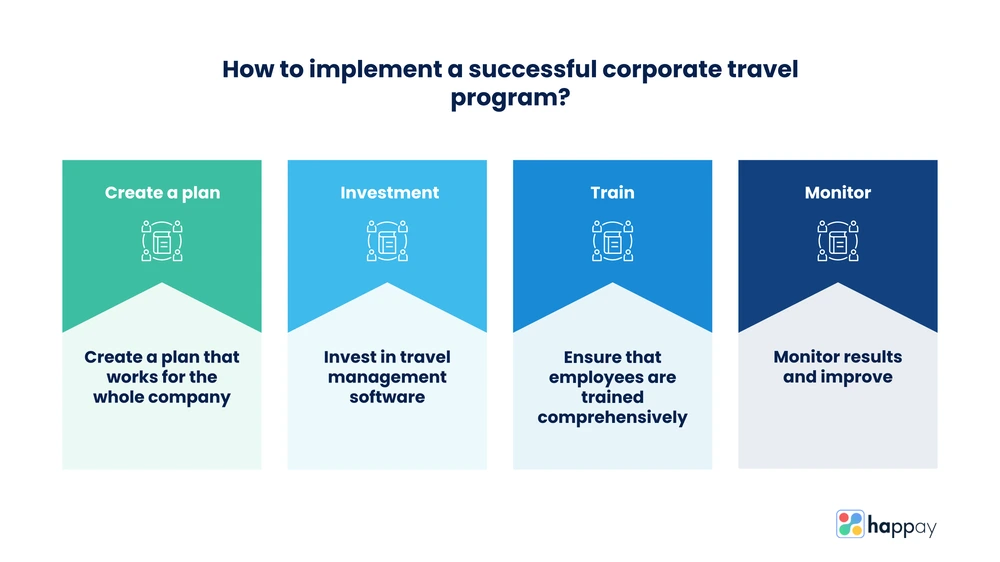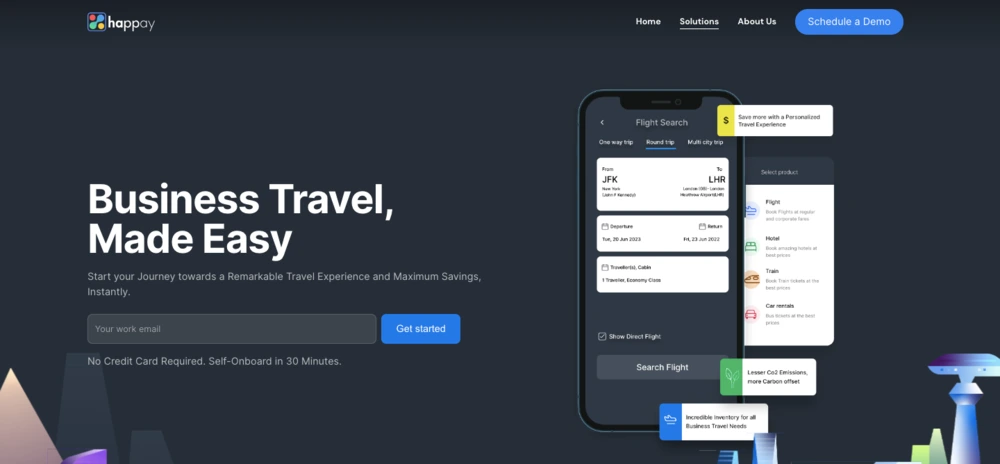Last Updated on November 28, 2025
Corporate travel program
You arrive at the office at 9:00 am, a little later than usual, with a slight headache. You sit down at your desk to do a quick email and phone check before brewing your morning coffee.
To your dismay (but not exactly to your surprise), you have ten missed calls and six emails, all from the sales guy who’s finishing up a business trip. He has some serious logistical problems, and he needs your help immediately to resolve them.
Two hours and seven phone calls later, the sales guy is taken care of, but you’re stressed, already behind on your work, and your headache has worsened. And you still haven’t had your morning coffee.
If this nightmare seems at all familiar, you may want to consider implementing a corporate travel program.
This article covers everything you need to know about getting started: how these programs work, how they can help your business, how to implement them, as well as recommendations for the best travel and expense software solutions.
Also, Read: A Business Guide to Corporate Travel Management
What is a corporate travel program?
A corporate travel program, or business travel program, is a broad term that refers to a defined system of business travel policies, guidelines, and roles within a company, designed to increase the efficiency and ease of the business travel experience.
Why does your business need a corporate travel program?
Corporate travel management programs provide a myriad of benefits which will be discussed in more detail in another section below. In short, suffice it to say that as the business world continues to modernize and streamline, those companies that want to stay in business will need to adapt to this higher level of efficiency or get left behind.
A good business travel program will allow your employees and managers to spend less time on tedious business travel planning and more time completing meaningful tasks and making key company decisions.
Additionally, a corporate travel program can be incredibly beneficial for employees. There are many different teams within a company that are involved in and affected by the processes governing corporate travel and expenses:
- Accounts payable teams need to process invoices from vendors like airlines and hotels, as well as pictures of (crumpled) receipts from traveling employees.
- Finance teams need to review and categorize these processed expenses.
- Managers need to analyze the trends of these expenses and make big-picture plans for the future.
In all of these examples, a corporate travel program would assist greatly in enhancing efficiency.
Quick Read: What is a Corporate Booking Tool?
How does a corporate travel program work?
There are two main ways in which corporate travel programs function:
- Primarily by the means of software offered by a corporate travel management company, a corporate travel program codifies and standardizes corporate travel policies company-wide. This means that everything from categorized travel spend limits to general business travel guidelines are readily available to traveling employees, eliminating repetitive, time-consuming questions. Happay offers one of the best travel expense management software solutions on the market today.
- Whether accomplished internally or through outsourcing to a travel agency, a good business travel program will ensure the presence of a dedicated group of travel support staff, ready and on-call 24/7.
This means that any issues or emergency travel needs (such as canceled flights or problems with car rentals) will be resolved quickly, effectively, and without forcing any employee or manager to abandon their own time-sensitive tasks to assist.
What does a corporate travel manager do?
A corporate travel manager is an integral part of a corporate travel program. Put simply, these managers set the rules that the program then follows. Duties include assembling monthly or annual travel budgets, creating initial business travel guidelines and best practices, and negotiating terms with any third-party agencies.
To be clear, if there is a good business travel program in place, the travel manager will perform only the necessary “rule-setting” tasks within this framework. For example, the manager will set the monthly or yearly budgets, but a travel and expense management software like Happay will ensure that the employees stick to the travel budget.
Quick Read: Travel and Expense Management Process
Benefits of corporate travel programs
There are many, many benefits to implementing a corporate travel program for your business. Five of the most significant are listed below.
- A properly utilized corporate travel program will greatly increase company efficiency, which could actually lead to an increase in the bottom line. Managers who would otherwise be assisting with logistical travel planning will instead be able to focus solely on advancing the objectives of the company.
- Through the use of corporate credit cards and negotiable contract deals, a managed travel program can reduce business travel expenses in the short term.
- Travel management software is an invaluable aspect of a business travel program, as it will greatly streamline the entire business travel process, from booking flights and accommodations to recording and approving receipts.
- Any travel emergencies will be courteously taken care of by a 24/7 support team, whose sole purpose is to assist traveling employees during the inevitable events of unexpected changes and cancellations.
- Increased procedural visibility and travel spend efficiency will allow traveling employees to focus clearly on the actual reasons they’re traveling in the first place: to make sales and to build customer and client relations.
Corporate travel rewards program
A rewards program can be another huge benefit to implementing a corporate travel program. Many corporate travel programs seamlessly incorporate rewards offered by airlines and hotels. In exchange for the use of their travel services, many of these organizations reward users with either points or actual cash.
Points can be used to reduce airfare, purchase future flights, book accommodations and upgrades, and more. With travel management software, tracking and redeeming these rewards becomes a simple process.
Uses of corporate travel cards in your travel program
Many travel management software companies offer corporate credit cards, either individually or included with a purchase of software. Corporate cards:
- Eliminate the need for employees to spend their own money and wait for reimbursements
- Can be programmed with travel spend limits, ensuring that traveling employees don’t spend over budget
- Provide high rewards rates for any expenditures related to business travel.
In particular, Happay’s World Travel Card offers substantial benefits:
- When traveling in foreign countries, use the World Travel Card with zero cross-currency markup.
- Switch cards on or off as needed to prevent fraudulent spending.
- Set card limits to ensure employees stay within budget.
- Withdraw cash at over 2 million ATMs around the world.
- Pay with the World Travel Card at over 37 million international outlets.
Corporate travel program best practices
Some corporate travel programs are better than others. Below are three elements that the best managed travel programs almost always incorporate.
- Companies should automate their corporate travel policies and procedures wherever possible. It is a waste of company time and resources for managers and employees to actively complete tasks that could be completed for free by technology.
- A good corporate travel program should place all booking options and features in one location or application; this will result in the greatest possible transparency and simplicity. Corporate travel management software is essential for this, as it is the only way to implement a complete end-to-end travel solution.
- Ensure that your business travel program is easy for employees to understand and use. It goes without saying that a program that no one wants to use will not be of much help at all. In general, the simpler this process is for traveling employees, the better.
Best corporate travel management software
As the travel industry has grown, so has the number of travel management companies. It is difficult to definitively define the “best” corporate travel management software, as the providers differ greatly from one another, and not all market themselves to the same business types or sizes. Nevertheless, our top five travel management companies are listed below.
- Happay tops the list as it provides an excellent business travel management solution. It is known for its versatility, usability, ease of implementation and innovative features.
- SAP Concur works well for large enterprises due to its customization potential and complex workflows.
- Ramp is a travel management solution that focuses on creating the simplest and most streamlined user process.
- Brex offers powerful corporate cards with credit limits 10-20x higher than those of competitors.
- TravelPerk provides an online booking tool with the largest inventory of travel booking options for its users, resulting in increased flexibility.
Quick Read: 8 Best TravelPerk Alternatives and Competitors
How to implement a successful corporate travel program?
Implementing a successful corporate travel program is a detailed process that will vary from company to company. The basic steps are as follows:

1. Create a plan that works for the whole company
Before implementing any software or procedures, a good travel manager should create a detailed plan, working with every department in the company to ensure that the most important needs and requirements will be met by the program. Suggestions include:
- Create a detailed series of travel budgets
- Compile a list of potential choices for travel management software
- Create a set of fleshed-out compliance procedures that apply company-wide.
2. Invest in travel management software
Travel management software is essential to creating a truly streamlined business travel program. No matter how detailed the planning, budgeting, and compliance processes, there will be headaches if all details are not brought together under one roof—that is, integrated into an end-to-end travel management software.
Most companies offering these solutions provide dedicated customer service that will assist you throughout the entire onboarding and integration process. Here are some points to consider when choosing a travel management software solution:
- How large and complex is my business? How advanced are my requirements?
- What departments would benefit most from this software, and what features would help them the most?
- What industry-specific needs should this software meet?
- How fast will the onboarding process be?
3. Train employees
Even under the simplest and most intuitive of systems, you will need to ensure that employees are trained comprehensively on how to fully utilize the travel management software and travel agent support. Proper training at inception will prevent time-consuming questions down the line. Keep the following points in mind when training employees:
- Meetings and formal trainings are helpful, but practical, hands-on training is usually most effective
- Prioritize those departments that will be most heavily using the software
- Save time by only training employees on processes they’ll be using; don’t train everyone on everything.
4. Monitor results and improve
Many travel management software companies offer automatic analytics engines that compile employees’ travel data and translate it into intelligible charts and graphs for easy review. Make full use of these features and continually improve corporate traveling habits in order to maximize travel cost savings. Things to consider:
- Analyze travel expense trends over both the short-term and the long-term
- Cost savings aren’t everything; consider time savings in your analyses as well
- When needed, use a travel management software to drill down on specific details such as individual employee spending.
Also, Read: A Guide to Business Travel Management
Why choose Happay’s travel management software for your corporate travel program?
Happay is a travel management company that offers one of the best software solutions in the market today.

1. Complete trip management from one platform
Booking travel arrangements and flights, approving expense request forms, creating itineraries, and analyzing spending trends all take place on a single platform. Additionally, all travel-related communication occurs within Happay’s ecosystem, eliminating the need to keep track of separate emails, voicemails and memos.
2. Strong policy engine
Happay uses smart automation to effectively enforce company policy. Delays in approval time (which often contribute to increased airfares) are significantly reduced with Happay’s flexible, multi-level trip and cost approval system. Happay also grants increased visibility of spending rules and corporate travel policies to traveling employees.
3. Smart analytics
Happay automatically compiles your company’s travel and expense data into easy-to-read reports. Filter the data into different categories to analyze spending trends from every angle. Seeing the big picture and making smart company decisions is easier than ever with Happay.
4. Tested and proven to be effective
Happay is used by over 6,000 customers and in 20+ countries. Some of the most successful users include large enterprises like PWC, AGC, and Domino’s Pizza. Happay has been proven to be an immensely reliable and universally effective travel solution.
Also, Read: Travel Expense Reimbursement Process
Conclusion
Whether you work for a two-month-old startup or a well-established corporation, a corporate travel program can benefit your company in more ways than one—and generally, the sooner you implement such a solution, the more substantial your business’s profits will be in the future.
Implement a corporate travel program, and you will save yourself and others from future headaches with a success rate greater even than that of ibuprofen.
FAQs
Corporate travel can take many forms. Some of the most common examples of corporate travel include:
a) Traveling to another branch or office of your company
b) Traveling to meet with business partners or suppliers to communicate face-to-face
c) Traveling to sell a good or service to a client.
Some trips can take weeks, while others take only hours.
Building a corporate travel program can be a complex undertaking. However, the general process involves:
a) Creating a detailed plan that works for the whole company
b) Investing in quality travel management software
c) Training employees on how to effectively use the software
d) Continually monitoring spending trends and improving the program.
The primary advantage of a corporate travel program lies in the efficiency gains that result from having everything travel-related located in one place and unified under a standard set of best practices and procedures.
Due to this increase in efficiency, as well as rewards and discounts offered by business travel management agencies, your business will end up generating significant travel cost savings. Further, your bottom line will improve in both the long-term and the short-term.
Corporate travel involves traveling for the express purpose of advancing organizational goals. Though some employees may greatly enjoy the corporate travel experience and may even have days off in which they are told to enjoy themselves, the main purpose of such travel is to benefit the company.
In contrast, leisure travel is for personal enjoyment and/or advancing personal goals as opposed to company goals.










Discussion about this post